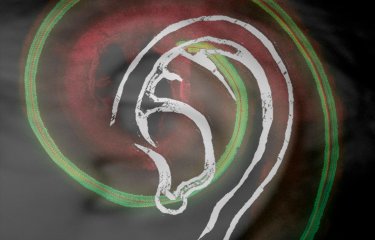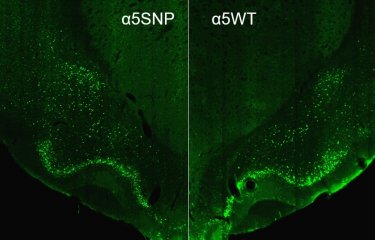Presbycusis, or age-related hearing loss, involves genetic and environmental factors. A genomic analysis can identify gene variants whose pathogenicity subsequently needs to be confirmed. As a general rule, frequent variants have little or very little effect; it is their cumulative impact in several genes that explains the impairment. Ultra-rare variants, on the other hand, have a strong impact and can result in monogenic forms of hearing loss; they are caused by one or more mutations in a single gene. Scientists investigated cases of presbycusis occurring around the age of 50, some affecting several members of the same family, to look for ultra-rare variants. A quarter of cases presented ultra-rare mutations in genes responsible for hearing loss in children. Their pathogenicity was established by performing complementary analyses, which included introducing the same mutation in mice. These forms of monogenic presbycusis represent promising targets for gene therapy, which was previously only under development for forms of early-onset hearing loss.
Presbycusis is age-related hearing loss. "It affects more than a third of people over the age of 65 and is a major source of disability," explains Christine Petit, a Professor at the Institut Pasteur and at the Collège de France and Director of the Hearing Institute, an Institut Pasteur center for auditory neuroscience research that opened in early 2020. She continues: "Presbycusis is the main modifiable risk factor for dementia. The variable expression of the disorder can be attributed to the involvement of several causal factors, both genetic and environmental, that contribute in roughly equal proportions to hearing loss."
The genetics of moderate presbycusis
Genome-wide association studies (GWAS) can be used to analyze multiple genetic variations in several individuals to examine their correlation with phenotypic traits such as age-related hearing loss. Studies of this type suggest the existence of polygenic forms (involving several genes) of presbycusis, with a large number of variants in multiple genes. These variants are frequent but each one only has a slight impact. For this type of presbycusis, gene therapy is currently ineffective because it is impossible to correct multiple genes in a cell. Other therapies, including pharmacological approaches, may be developed if the various gene mutations are found to contribute to the impairment of a single function.
Discovery of ultra-rare variants in 35 genes already implicated in hearing loss in children
"That's why we set out to search for ultra-rare variants (with an allele frequency of less than one in ten thousand), indicating monogenic forms of presbycusis, for which gene therapy may be possible," explains Christine Petit.
This research, involving several French clinical teams, focused on two cohorts of around a hundred volunteers, with both family and sporadic cases. The patients were selected because they had presbycusis that had occurred around the age of 50, with a degree of hearing loss that would be considered severe for people 20 years older. The sequences of all the exons were compared in the subjects with hearing loss and the "controls" with normal hearing.
"The study revealed ultra-rare variants of 35 genes known to play a part in dominant autosomal forms of hearing loss in children," explains Paul Avan, a Professor at the University of Clermont Auvergne and Director of the future Center for Research and Innovation in Human Audiology (CERIAH).
Variants of interest found in a quarter of subjects with presbycusis
The genes found include those encoding unconventional myosins, proteins that play an important role in the function of auditory sensory cells. In general, "variants of interest were observed in a quarter of subjects with presbycusis occurring around the age of 50, both familial and sporadic cases, as opposed to just a few percent in controls," continues Paul Avan. Half of these variants had never been described.
The next task was to demonstrate their pathogenicity by using a combination of various methods to demonstrate that the variants modify the three-dimensional structure of the protein encoded by the gene, prevent the activity of the protein or inhibit its synthesis. In most of the subjects with hearing loss, just one of the two copies of the gene was affected, explaining the onset of hearing loss in adulthood. Direct evidence of pathogenicity was found in a variant of the TMC1 gene, which encodes a protein in the mechanotransduction channel of auditory sensory cells. In mice, when both copies of the gene contained the variant observed in humans, early-onset hearing loss was observed. When just one of the copies contained the variant, the result was as expected.
"This mutant mouse whose hearing was initially normal exhibited typical presbycusis that progressively worsened from 3 to 7 months," continues Paul Avan.
"The genetics of presbycusis therefore reveals a continuum of monogenic forms of hearing loss, from impairments at birth, where both copies of the gene often contain mutations that totally inactivate them, to forms where just one copy contains an ultra-rare variant whose effect is only felt at a later stage, in which the late onset cannot systematically be correlated with the predicted severity of the impact of the variant," explains Christine Petit.
The existence of these particularly frequent monogenic forms should pave the way for the development of inner ear gene therapy in adults.
The support of a national network formed in response to a collaborative work call on presbycusis.
• Didier Bouccara : Hôpital Beaujon, Hôpitaux Universitaires Paris Nord val-de-Seine, APHP, 92110 Clichy, France.
• Bernard Fraysse, Olivier Deguine : Centre Hospitalier Universitaire, Hôpital Larrey, Service d’Oto-Rhino-Laryngologie et Chirurgie Cervico-Faciale, Toulouse, France.
• Lionel Collet : Centre Hospitalier Universitaire, Hôpital Lyon-Sud, Audiologie et Explorations Orofaciales, 69495 Lyon, France.
• Hung Thai-Van, Eugen Ionescu : Centre Hospitalier Universitaire, Hôpital Edouard Herriot, Exploration Fonctionnelle Audiologie et Vestibulaire, 69437 Lyon, France.
• Hung Thai-Van : Claude Bernard University Lyon 1, 69100 Villeurbanne, France.
• Jean-Louis Kemeny : Centre Hospitalier Universitaire, Hôpital Gabriel Montpied, Service d'Anatomo-Pathologie, 63000 Clermont-Ferrand, France.
• Fabrice Giraudet, Paul Avan : UMR 1107, Institut National de la Santé et de la Recherche Médicale (INSERM), 63001 Clermont-Ferrand, France. Laboratoire de Biophysique Neurosensorielle, Faculté de Médecine, Université Clermont Auvergne, 63001 CleThe support of a national network formed in response to a collaborative work call on presbycusis.rmont-Ferrand, France.
• Paul Avan : Centre Jean Perrin, 63000 Clermont-Ferrand Cedex 01, France.
• Jean-Pierre Lavieille, Arnaud Devèze : Centre Hospitalier Universitaire, Hôpital Nord, Service d’Oto-Rhino-Laryngologie, 13015 Marseille, France.
• Anne-Laure Roudévitch, Anne Aubois : Centre Hospitalier National d'Ophtalmologie des Quinze-Vingts, Centre d'Investigation Clinique, 75012 Paris, France.
• Christophe Vincent : Centre Hospitalier Universitaire, Hôpital Roger Salengro, Service d’Otologie et Otoneurologie, 59000 Lille, France.
• Christian Renard : Laboratoire d’Audiologie Renard, 59000 Lille, France.
• Valérie Franco-Vidal, Vincent Darrouzet, Claire Thibut-Apt : Centre Hospitalier Universitaire, Hôpital Pellegrin, Service d’Oto-Rhino-Laryngologie et Chirurgie Cervico-Faciale, 33076 Bordeaux, France.
• Eric Bizaguet, Arnaud Coez : Laboratoire de Correction Auditive, Eric Bizaguet, 75001 Paris, France.
• Arnaud Coez : CEA-Inserm U1000 Neuroimaging and Psychiatry, Service Hospitalier Frédéric Joliot, 91400 Orsay, France et CEA, DRM, DSV, Service Hospitalier Frédéric-Joliot, 91400 Orsay, France.
Source
Ultra-rare heterozygous pathogenic variants of genes causing dominant forms of early-onset deafness underlie severe presbycusis, PNAS, November 23, 2020
Sophie Bouchera,b,c,d, Fabienne Wong Jun Taia, Sedigheh Delmaghania, Andrea Lellia, Amrit Singh-Estivaletab, Typhaine Duponta, Magali Niasme-Grarea,e, Vincent Michela, Nicolas Wolfff, Amel Bahloula, Yosra Bouyacouba, Didier Bouccarag, Bernard Fraysseh, Olivier Deguineh, Lionel Colleti, Hung Thai-Vana,j,k, Eugen Ionescuj, Jean-Louis Kemenyl, Fabrice Giraudetm,n, Jean-Pierre Lavieilleo, Arnaud Devèzeo, Anne-Laure Roudevitch-Pujolp, Christophe Vincentq, Christian Renardr, Valérie Franco-Vidals, Claire Thibult-Apts, Vincent Darrouzets, Eric Bizaguett, Arnaud Coezt,u,v, Hugues Aschardw, Nicolas Michalskia, Gaëlle M. Lefevrea, Anne Auboisp, Paul Avana,m,n,x,1, Crystel Bonneta,b,1,2, Christine Petita,y,1,2
a Institut de l’Audition, Institut Pasteur, INSERM, 75012 Paris, France; b Complexité du Vivant, Sorbonne Universités, Université Pierre et Marie Curie, Université Paris 06, 75005 Paris, France; c Centre Hospitalier Universitaire, Service d’Oto-Rhino-Laryngologie et Chirurgie Cervico-Faciale, 49100 Angers, France; d Faculté de Médecine, Unité de Formation et de Recherche Santé, Université d’Angers, 49100 Angers, France; e Service de Biochimie et Biologie Moléculaire, Hôpital d’Enfants Armand-Trousseau, Assistance Publique-Hôpitaux de Paris (AP-HP), 75012 Paris, France; f Unité Récepteurs-Canaux, Institut Pasteur, 75015 Paris, France; g Hôpital Beaujon, Hôpitaux Universitaires Paris Nord val-de-Seine, AP-HP, 92110 Clichy, France; h Centre Hospitalier Universitaire, Service d’Oto-Rhino-Laryngologie et Chirurgie Cervico-Faciale, Hôpital Larrey, 31400 Toulouse, France; i Centre Hospitalier Universitaire, Audiologie et Explorations Orofaciales, Hôpital Lyon-Sud, 69495 Lyon, France; j Centre Hospitalier Universitaire, Exploration Fonctionnelle Audiologie et Vestibulaire, Hôpital Edouard Herriot, 69437 Lyon, France; k Claude Bernard University Lyon 1, 69100 Villeurbanne, France; l Centre Hospitalier Universitaire, Service d’Anatomo-Pathologie, Hôpital Gabriel Montpied, 63000 Clermont-Ferrand, France; mUnité Mixte de Recherche (UMR) 1107, INSERM, 63001 Clermont-Ferrand, France; n Laboratoire de Biophysique Neurosensorielle, Faculté de Médecine, Université Clermont Auvergne, 63001 Clermont-Ferrand, France; o Centre Hospitalier Universitaire, Service d’Oto-Rhino-Laryngologie, Hôpital Nord, 13015 Marseille, France; p Centre Hospitalier National d’Ophtalmologie des Quinze-Vingts, Centre d’Investigation Clinique, 75012 Paris, France; q Centre Hospitalier Universitaire, Service d’Otologie et Otoneurologie, Hôpital Roger Salengro, 59000 Lille, France; r Laboratoire d’Audiologie Renard, 59000 Lille, France; s Centre Hospitalier Universitaire, Service d’Oto-Rhino-Laryngologie et Chirurgie Cervico-Faciale, Hôpital Pellegrin, 33076 Bordeaux, France; t Laboratoire de Correction Auditive, Eric Bizaguet, 75001 Paris, France; u Commissariat à l’Energie Atomique (CEA)-INSERM U1000 Neuroimaging and Psychiatry, Service Hospitalier Frédéric Joliot, 91400 Orsay, France; v CEA, Direction de Recherche Médicale, Direction des Sciences du Vivant, Service Hospitalier Frédéric-Joliot, 91400 Orsay, France; wCentre de Bioinformatique, Biostatistique et Biologie Intégrative, Institut Pasteur, 75015 Paris, France; x Laboratoire de Biophysique, Centre Jean Perrin, 63000 Clermont-Ferrand, France; and y Collège de France, 75005 Paris, France









